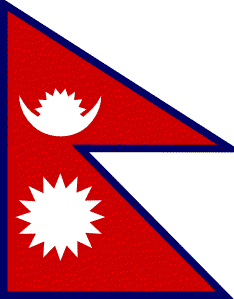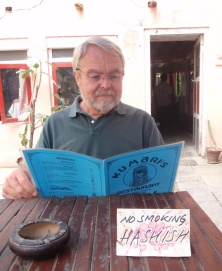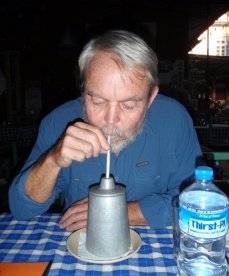NEPAL

Nepal has been shaped by its geography. Nepal is bordered by Tibet to the north and India to the south. It has been a meeting point between the Mongoloid peoples of Asia and the Caucasoid peoples of India.
Neolithic tools suggest that the Kathmandu valley has been populated for at least 9,000 years. However, the earliest recorded history dates only to the 7th to 8th century BC.
Nepal’s known history has followed a series of dynasties. The first known dynasty – the Kirati dynasty – dates back to the 7th to 8th century BC. The most recent dynasty – the second reign of the Shah dynasty – continued until 2008 when the monarchy was abolished.
The dynasties provide a framework within which Nepal’s early history can be organized. Nepal’s early history and through World War II follows the course of six dynasties – Kirati, Licchavi, Thakuri, Malla, Shah, and Rana.
Kirati Dynasty: The Kirati dynasty was Mongoloid Hindus who ruled Kathmandu valley in the 7th to 8th century BC. This dynasty established Hinduism in the valley; however, Buddhism arrived shortly thereafter. The widely known Indian Buddhist Emperor Ashoka visited the valley around the 2nd century BC.
Licchavi Dynasty: The Licchavi dynasty, from northern India, overthrew the reigning Kirati king. During the Licchavi dynasty, Hinduism increased and Buddhism decreased. By 300 AD, this dynasty established caste divisions and implemented social/religious traditions that persist today.
Thakuri Dynasty: The Thakuri dynasty came to power in 602 AD. The king reinforced his relationships with his neighbors by marrying his sister to an Indian prince and his daughter to a Tibetan prince.
The Dark Ages: Little else is known from the late 7th century to the early 13th century. It is known, however, that Kathmandu – then called Kantipur – was established around the 10th century.
Malla Dynasty: The Mallas, whom had been forced out of India, assumed power in the early 13th century. The Malla rule remained stable in the Kathmandu valley for a few hundred years. However, when King Yaksha died, his three sons divided the valley in to the three kingdoms of Kathmandu, Bhaktapur, and Patan.
The three kingdoms fought over trade routes to Tibet, and they competed with each other in the development of art and culture. Each kingdom built its own Durbar Square (durbar means ‘palace’), and those relics remain today.
Outside of the Kathmandu valley, today’s Nepal was still comprised of 46 separate states– each having its own army and monetary system. Those states would be unified under the Shah dynasty.
Shah Dynasty: Nepal was unified under King Prithri Narayan Shah in 1769. The capital was established in Kathmandu.
Shortly thereafter, in 1792, Nepal clashed with the Chinese in Tibet. Nepal was soundly defeated resulting in Nepal paying tribute to the Chinese emperor until 1912.
Also in 1792, the first British envoy arrived in Kathmandu. British power was increasing on the sub-continent, and Nepal eventually went to war against Britain from 1810 till 1816. This war ended with the Sugauli treaty.
Nepal also closed its borders in 1816, and the borders remained closed until 1951. For 135 years, few westerners, other than a few British residents, saw inside Nepal.
Despite their adversarial history, Nepal supported the British during the Indian War of Independence. In appreciation, the British returned some land – including some that they had obtained in the Sungauli treaty – and the national borders of today were established. The British also appreciated the fighting abilities of the Nepalis, and they brought Gurkha mercenaries in to the British army – a group that persists still.
Rana Dynasty: Jung Bahadur organized a massacre in 1846 that ended the Shah dynasty. This massacre killed hundreds of important men gathered together in the Kot courtyard within Kathmandu’s Durbar Square. Following the massacre, he took the title of Prime Minister, and he changed his name to the more prestigious ‘Rana’.
The Ranas became the ‘second royal family’, and they usurped power from the Shah dynasty. The Shah kings remained only as figureheads. And although Nepal’s development stagnated during the Rana dynasty, they held power for more than a century.
There were many changes elsewhere in the region after World War II. India had gained its independence from the British. The communist revolution was developing in China, and many Tibetan refugees fled to Nepal. Within Nepal, the Shah King, Tribhuvan, prepared to overthrow the Rana dynasty.
Shah Dynasty Returns to Power
In 1950, King Tribhuvan escaped from the palace to the Indian embassy and to India. From the border region, the Nepali Congress Party (NPC) was established, and they formed a provisional government. India negotiated a settlement between the Rana and Shah governments, and King Tribhuvan returned in 1951 to set up a new government. This government was comprised of Ranas and commoners from the NPC. A slow process of change started.
In the early 1950s, Nepal opened their borders, and they established relations with other countries. King Tribhuvan died in 1955, and his son, Mahendra, assumed the throne. In the late 1950s, a new constitution provided for a parliamentary system of government, and Nepal’s first general election was held in 1959.
In the 1960s, King Mahendra was unhappy with the system of government, and he seized political control. He established the ‘panchayat’ system which was comprised of chosen, rather than elected, individuals through which the power remains with the king. The cabinet was arrested, and political parties were banned.
In 1972, King Mahendra died, and he was followed by his British-educated son, Birenda. However, there remained much national discontent with governmental corruption and the slow process of change, and riots erupted in Kathmandu in 1979. In response, King Birenda announced a referendum through which Nepalis could select their type of government, and 55% of the electorate voted to continue the panchayat as compared to 45% wanting political parties.
In the early 1980s, a constitution was drafted which appeared to offer freedom of speech, right to peaceful assembly, and the right to form unions and assemblies (providing these were not politically motivated). However, in reality, the Nepalis experienced strict censorship, the police and military were not being held publicly accountable, and mass arrests, beatings, and torture occurred. In 1989, the Jana Andolan – People’s Movement – formed. This was a coalition of opposition parties that wanted a multiparty democracy with the king as a constitutional head.
In February of 1990, the government responded to non-violent protest meetings with bullets, tear gas, arrest, and torture. This was followed by rioting, curfews, strikes, and threats of withdrawal of foreign aid. The government backed down, and on April 9, 1990, the king lifted the ban on political parties. A week later he asked the opposition parties to lead an interim government. The king became a constitutional monarch.
Maoist Uprising
In May, 1991, twenty parties were in contention for election to parliament. The NPC won 38% majority vote closely followed by the Communist Party’s 28%. Conditions did not improve, and by April, 1992, there was a general strike with street violence and deaths. Another election was held mid-term in late 1994, and there was again no clear mandate. Coalitions were formed and broken; corruption and opportunism were rife.
Civil War: In 1996, the Maoists – part of the Communist Party of Nepal – declared a “People’s War”. This war pitted the ‘haves’ against the ‘have nots’, and it spiraled out of control. By 2001, the Maoists were attacking army barracks outside Kathmandu, and by 2002, nearly 8,000 were dead. However, the nation focused on 10 particular killings – the royal family.
On June 1, 2001, Crown Prince Dipendra, son of King Birenda, shot and killed nine members of the royal family including his king/father and queen/mother. He then shot himself, and he died in hospital two days later. Nepal was reeling with shock and grief as King Birenda’s brother, Gyandera, assumed the throne.
However, the Maoists resumed their efforts, and in April, 2002, they paralyzed the country with a five day strike. There were intense clashes between the military and the rebels during this time.
By October, 2002, King Gyandera was frustrated with the political stalemate, and he dissolved the government and appointed a new prime minister. The rebels challenged the constitutionality of these moves, and they staged more rallies and strikes. Finally, on January 29, 2003, the Nepal government and the Maoists reached a cease-fire agreement, but it did not last.
In early 2005, King Gyandera assumed absolute authority in Nepal. The Maoists responded by declaring a three-month unilateral cease fire to negotiate their demands.
In 2006, King Gyandera agreed to reinstate parliament which had not met for four years. The new government signed a peace agreement with the Maoists late in 2006, and the constituent assembly voted for the abdication of the king.
Some Maoists joined the interim parliament in early 2007, but they quit later that same year when the monarchy refused to abdicate. The king did abdicate on May 28, 2008, and Nepal became a democratic republic. The civil war had cost 13,000 lives.
All is not well, still…
Less than two months after becoming the Federal Democratic Republic of Nepal, Dr. Ram Baran Yadav became the first president. A few weeks later, Maoist leader Prachanda was elected Prime Minister. However, Prachanda resigned his position on May 4, 2009, over conflicts with the army chief. Meanwhile, the people still sense a lack of representation, and vigilante justice prevails in the rural areas. Nepal remains a political hotbed, and it appears ready to reignite at the slightest provocation.
Nepal’s borders expanded and contracted through its early years, but those borders have been stable since 1858. Nepal is a relatively small country wedged between its two giant neighbors of China and India.
Nepal is comprised of 54,363 square miles. Mountains cover 80% of that, and only 16% of the land is arable.
Northern Nepal includes much of the Himalayan Mountains (Himalaya is Sanscrit for ‘abode of snows’). The Nepali Himalayas include eight of the world’s ten highest mountain peaks including Everest which is the tallest at 29,029 feet. The central part of Nepal is comprised of hill country and fertile valleys. The southern region is part of the flat subtropical Ganges Plains.

Lunch on Freak Street
Nepal is no longer a kingdom, and it has been a republic since May 28, 2008. Its capital is Kathmandu which has long been the urban center of Nepali life.
Nepal’s population is estimated to be near 30 million, and it is increasing rapidly. Approximately one million live in the Kathmandu valley, and about half of those live in the city of Kathmandu itself. Thus, this is a rural population.
It is also a multiethnic population with no ethnicity exceeding more than 16% of the overall population. Nepali is the official language; however, it has 30 dialects, and at least twelve other languages are commonly spoken.
Nepal’s official religion is Hinduism. Nepal has the greatest percentage of Hindus of any country with 81% identifying themselves as Hindu. Nepal is also the birthplace of Siddhartha Guatama who became the Buddha, and 11% of Nepalis identify as Buddhists. Only 4% are Muslim, and the remaining 4% practice various other religions.
Nepal’s life expectancy is less than 61 years. Their literacy rate is less than 49%.
Nepal is one of the poorest countries in the world. Their GDP is the equivalent of $220 USD per person; however, many operate outside of the cash economy. Their labor force is 76% agricultural, 6% industrial, and 18% service.
The Nepali rupee (NPR) is their currency, and one US dollar is equivalent to approximately 80 NPRs. One NPR is equivalent to approximately $0.0125 USD.
Nepal’s main industries are tourism, carpets, and textiles. Their main agricultural products are rice, corn, wheat, and sugarcane. However, foreign aid is vital to Nepal’s economy. In 2001, 58% of the government’s total development budget came from foreign aid.
Nepal’s flora and fauna merit mention because of their appeal to tourists, thus their importance to the nation’s economy. There are 6,500 known species of trees, shrubs, and wildflowers in Nepal, but the fauna is the draw for most tourists.
Nepal has 800 known bird species. Their mammals include the Bengal tiger, leopard, one-horned rhinoceros, Indian elephant, goat, sheep, jackal, hares, bats, and several species of deer, monkey, and bear. Their reptiles include snakes, lizards, and two species of crocodile.
Most climbers and trekkers are drawn to the Himalayas in the north. Most wildlife enthusiasts are drawn to the national parks in the south. Nepal claims to have the best wildlife safaris in all of Asia. They certainly have the diversity of animals.

Drinking Tibetan tongba
As our flight approached Kathmandu, we could see the top of Mount Everest above the solid cloud layer below. No other peaks emerged above the clouds. But that would be the last look we got of Everest for a while. We got our first view of Nepal’s dreadful air pollution while still in the air, and that pollution would continually obscure our views of the Himalayas that we had come to see.
We landed in Kathmandu, and it was a sensory overload – the sights, sounds, smells. We got through the relatively unfriendly immigration process, and we looked forward to checking in to our hotel then walking around town a bit.
The roads and traffic were shocking. The roads are in dreadful condition, and the driving is maniacal (and we have been in Asia long enough to know maniacal driving).It was a bit frightening, but at least the condition of the roads prevented the taxi driver from going very fast. We made a few circles before the driver finally stopped for directions and found our hotel. We were relieved to get there.
We checked in to the Kantipur Temple House for a brief stay before heading further west for some adventure. It was an interesting building of brick and wood, and it was very dark. We learned that electrical power was available for only two four-hour blocks each day. Unfortunately, those power blocks were from twelve to four o’clock – AM and PM. We were sleeping during the night block, and we were out during the afternoon block. So we pretended we were camping and wished for fans and warm showers. This was in the middle of the capital city – not some isolated outpost.
Our walkabout in the city was enlightening. It was noisy and colorful and often tactile – touching is common. We walked through colorful and busy markets. We visited Freak Street which appears like it probably did in the 1960s. We had a memorably good dinner at our hotel, and we took cool showers – both by candlelight, of course. Unfortunately it was already more annoying than charming or romantic. But all of Kathmandu was sharing our experience, and some outlying areas had even less power, so we did not complain too much (ok, Nita grumbled a bit over breakfast by candlelight).
We enjoyed the food in Nepal very much. At first, it seemed to us that the Indian influence was far greater than the Chinese influence, but we learned that many of our favorites were actually Tibetan. For example, we ate delicious little steamed dumplings called momos, and they were Tibetan. Our favorite dessert was a whipped yogurt dessert called shikani – also Tibetan. So, although the curries seemed heavily Indian influenced, the Tibetan influence was found in the more subtly flavored foods.
Bud also tried a few local brews. He drank rakshi – a distilled millet-based liquor – only once. But he found a few beers to his liking. He drank Gorka, Nepal Ice, and Everest. He also tried a Tibetan ‘beer’ called tongba. It is made from millet seed and served warm. This, too, he drank only once. He’ll stick with barley. But, overall, the food and drink in Nepal was quite good.
Our time in Nepal followed three different paths. First, we spent time southwest of Kathmandu on a wildlife safari followed by some sorely-needed relaxation at a peaceful resort. Second, we did a lot of sightseeing in and around Kathmandu valley visiting temples and villages. Third, we traveled east of the valley, did some easy trekking, and spent a few nights in the mountains. Each were unique experiences.
Follow us to western Nepal, Kathmandu valley, or eastern Nepal.